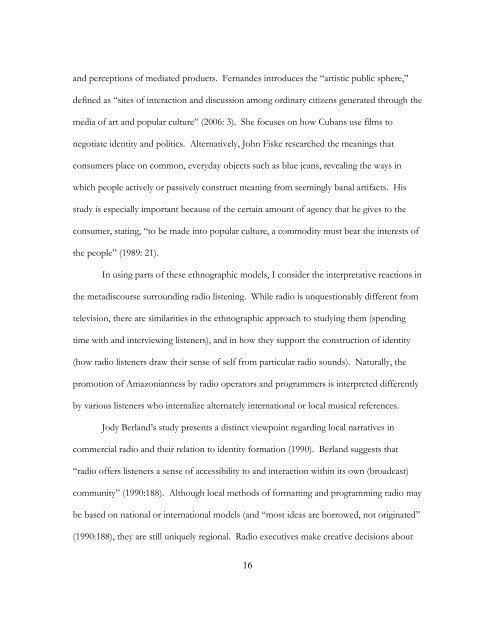Copyright by Kathryn Ann Metz 2010 - The University of Texas at ...
Copyright by Kathryn Ann Metz 2010 - The University of Texas at ...
Copyright by Kathryn Ann Metz 2010 - The University of Texas at ...
Create successful ePaper yourself
Turn your PDF publications into a flip-book with our unique Google optimized e-Paper software.
and perceptions <strong>of</strong> medi<strong>at</strong>ed products. Fernandes introduces the “artistic public sphere,”<br />
defined as “sites <strong>of</strong> interaction and discussion among ordinary citizens gener<strong>at</strong>ed through the<br />
media <strong>of</strong> art and popular culture” (2006: 3). She focuses on how Cubans use films to<br />
negoti<strong>at</strong>e identity and politics. Altern<strong>at</strong>ively, John Fiske researched the meanings th<strong>at</strong><br />
consumers place on common, everyday objects such as blue jeans, revealing the ways in<br />
which people actively or passively construct meaning from seemingly banal artifacts. His<br />
study is especially important because <strong>of</strong> the certain amount <strong>of</strong> agency th<strong>at</strong> he gives to the<br />
consumer, st<strong>at</strong>ing, “to be made into popular culture, a commodity must bear the interests <strong>of</strong><br />
the people” (1989: 21).<br />
In using parts <strong>of</strong> these ethnographic models, I consider the interpret<strong>at</strong>ive reactions in<br />
the metadiscourse surrounding radio listening. While radio is unquestionably different from<br />
television, there are similarities in the ethnographic approach to studying them (spending<br />
time with and interviewing listeners), and in how they support the construction <strong>of</strong> identity<br />
(how radio listeners draw their sense <strong>of</strong> self from particular radio sounds). N<strong>at</strong>urally, the<br />
promotion <strong>of</strong> Amazonianness <strong>by</strong> radio oper<strong>at</strong>ors and programmers is interpreted differently<br />
<strong>by</strong> various listeners who internalize altern<strong>at</strong>ely intern<strong>at</strong>ional or local musical references.<br />
Jody Berland‟s study presents a distinct viewpoint regarding local narr<strong>at</strong>ives in<br />
commercial radio and their rel<strong>at</strong>ion to identity form<strong>at</strong>ion (1990). Berland suggests th<strong>at</strong><br />
“radio <strong>of</strong>fers listeners a sense <strong>of</strong> accessibility to and interaction within its own (broadcast)<br />
community” (1990:188). Although local methods <strong>of</strong> form<strong>at</strong>ting and programming radio may<br />
be based on n<strong>at</strong>ional or intern<strong>at</strong>ional models (and “most ideas are borrowed, not origin<strong>at</strong>ed”<br />
(1990:188), they are still uniquely regional. Radio executives make cre<strong>at</strong>ive decisions about<br />
16

















